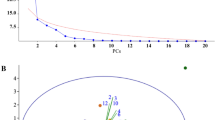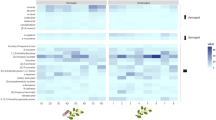Abstract
We investigated whether volatiles produced by spider mite-damaged plants of four gerbera cultivars differ in attractiveness to Phytoseiulus persimilis, a specialist predator of spider mites, and how the mite-induced odor blends differ in chemical composition. The gerbera cultivars differed in resistance, as expressed in terms of spider mite intrinsic rate of population increase (r m). In order of increasing resistance these were Sirtaki, Rondena, Fame, and Bianca. To correct for differences in damage inflicted on the cultivars, we developed a method to compare the attractiveness of the blends, based on the assumption that a larger amount of spider mite damage leads to higher attraction of P. persimilis. Spider mite-induced volatiles of cultivars Rondena and Bianca were preferred over those of cultivar Sirtaki. Spider mite-induced volatiles of cultivars Sirtaki and Fame did not differ in attractiveness to P. persimilis. Sirtaki plants had a lower relative production of terpenes than the other three cultivars. This was attributed to a low production of cis-α-bergamotene, trans-α-bergamotene, trans-β-bergamotene, and (E)-β-farnesene. The emission of (E)-β-ocimene and linalool was lower in Sirtaki and Fame leaves than in Bianca and Rondena. The importance of these chemical differences in the differential attraction of predatory mites is discussed.
Similar content being viewed by others
REFERENCES
ADAMS, R. P. 1989. Identification of Essential Oil Components by Gas Chromatography/Mass Spectroscopy. Academic Press, San Diego, 302 pp.
CRAWLEY, M. J. 1993. GLIM for Ecologists. Blackwell, Oxford., 379 pp.
DICKE, M., 1994. Local and systemic production of volatile herbivore-induced terpenoids: Their role in plant-carnivore mutualism. J. Plant Physiol. 143:465-472.
DICKE, M. 1999. Specificity of herbivore-induced plant defences, pp. 43-59, in D. J. Chadwick and J. Goode (eds.). Insect-Plant Interactions and Induced Plant Defence. Wiley, Chicester, UK (Novartis Foundation Symposium 223).
DICKE, M., and SABELIS, M. W. 1988. How plants obtain predatory mites as bodyguards. Neth. J. Zool. 38:148-165.
DICKE, M., BEEK, T. A. VAN, POSTHUMUS, M. A., BEN DOM, N., VAN BOKHOVEN, H., and DE GROOT, AE. 1990a. Isolation and identification of volatile kairomone that affects acarine predator-prey interactions. Involvement of host plant in its production. J. Chem. Ecol. 16:381-396.
DICKE, M., SABELIS, M. W., TAKABAYASHI, J., BRUIN, J., and POSTHUMUS, M. A. 1990b. Plant strategies for manipulating predator-prey interactions through allelochemicals: Prospects for application in pest control. J. Chem. Ecol. 16:3091-3118.
DICKE, M., TAKABAYASHI, J., POSTHUMUS, M. A., SCHüTTE, C., and KRIPS, O. E. 1998. Plant-phytoseiid interactions mediated by herbivore-induced plant volatiles: Variation in production of cues and in responses of predatory mites. Exp. Appl. Acarol. 22:311-333.
JOULAIN, D., and KOENIG W. A. 1998. The Atlas of Spectral Data of Sesquiterpene Hydrocarbons. EBV, Hamburg, 358 pp.
KRIPS, O. E., WITUL, A., WILLEMS, P. E. L., and DICKE, M. 1998. Intrinsic rate of population increase of the spider mite Tetranychus urticae on the ornamental crop gerbera: Intraspecific variation in host plant and herbivore. Entomol. Exp. Appl. 89:159-168.
KRIPS, O. E., KLEIJN, P. W., WILLEMS, P. E. L. GOLS, R., and DICKE, M. 1999a. Leaf hairs influence the searching efficiency and predation rate of the predatory mite Phytoseiulus persimilis. Exp. Appl. Acarol. 23:119-131.
KRIPS, O. E., WILLEMS, P. E. L., GOLS, R., POSTHUMUS, M. A., and DICKE, M. 1999b. The response of Phytoseiulus persimilis to spider mite-induced volatiles from gerbera: influence of starvation and experience. J. Chem. Ecol. 25:2623-2641.
LOUGHRIN, J. H., MANUKIAN, A., HEATH, R. R., and TUMLINSON, J. H. 1995. Volatiles emitted by different cotton varieties damaged by feeding beet armyworm larvae. J. Chem. Ecol. 21:1217-1227.
LOUGHRIN, J. H., POTTER, D. A., HAMILTON-KEMP, T. R., and BYERS, M. E. 1996. Volatile compounds from crabapple (Malus spp.) cultivars differing in susceptibility to the Japanese beetle (Popillia japonica Newman). J. Chem. Ecol. 22:1295-1305.
MATTIACCI, L., DICKE, M., and POSTHUMUS, M. A. 1994. Induction of parasitoid attracting synomone in Brussels sprouts plants by feeding of Pieris brassicae larvae: Role of mechanical damage and herbivore elicitor. J. Chem. Ecol. 20:2229-2247.
PELS, B., and SABELIS, M. W. 1999. Local dynamics, overexploitation and predator dispersal in an acarine predator-prey system. Oikos 86:573-583.
SABELIS, M. W. 1981. Biological control of two-spotted spider mites using phytoseiid predators. Part 1: Modelling the predator-prey interaction at the individual level. PhD thesis. Pudoc, Wageningen, 242 pp.
SABELIS, M. W. 1985. Life history: Capacity for population increase, pp. 35-41, in W. Helle and M. W. Sabelis (eds.). Spider Mites. Their Biology, Natural Enemies and Control, World Crop Pests, Vol 1B. Elsevier, Amsterdam.
SABELIS, M.W., and AFMAN, B. P. 1994. Synomone-induced suppression of take-off in the phytoseiid Phytoseiulus persimilis Athias-Henriot. Exp. Appl. Acarol. 18:711-721.
SABELIS, M. W., and VAN DE BAAN, H. E. 1983. Location of distant spider mite colonies by phytoseiid predators: Demonstration of specific kairomones emitted by Tetranychus urticae and Panonychus ulmi. Entomol. Exp. Appl. 33:303-314.
SABELIS, M. W., and VAN DER MEER, J. 1986. Local dynamics of the interaction between predatory mites and two-spotted spider mites, pp. 322-343, in J. A. J. Metz and O. Diekman (eds.). Dynamics of Physiologically Structured Populations. Lecture Notes in Biomathematics, Springer, Berlin.
SABELIS, M. W., and VAN DER WEEL, J. J. 1994. Anemotactic responses of the predatory mite, Phytoseiulus persimilis Athias-Henriot, and their role in prey finding. Exp. Appl. Acarol. 17:521-529.
SABELIS, M. W., VERMAAT, J. E., and GROENEVELD, A. 1984. Arrestment responses of the predatory mite, Phytoseiulus persimilis, to steep odour gradients of a kairomone. Physiol. Entomol. 9:437-446.
SAS Institute Inc. 1997. SAS/STAT Software: Changes and Enhancements through Release 6.12, SAS Institute Inc., Cary, North Carolina, 1167 pp.
SOUISSI, R. 1999. The influence of the host plant of the cassava mealybug Phenacoccus manihoti on the plant and host preferences of its parasitoid Apoanagyrus lopezi. Biol. Control 15:64-70.
SüTTERLIN, S., and VAN LENTEREN, J. C. 1997. Influence of hairiness of Gerbera jamesonii leaves on the searching efficiency of the parasitoid Encarsia formosa. Biol. Control 9:157-165.
TAKABAYASHI, J., and DICKE, M. 1992. Response of predatory mites with different rearing histories to volatiles of uninfested plants. Entomol. Exp. Appl. 64:187-193.
TAKABAYASHI, J., and DICKE, M. 1996. Plant-carnivore mutualism through herbivore-induced carnivore attractants. Trends Plant Sci. 1:109-113.
TAKABAYASHI, J., DICKE, M., and POSTHUMUS, M. A. 1994. Volatile herbivore-induced terpenoids in plant-mite interactions: Variation caused by biotic and abiotic factors. J. Chem. Ecol. 20:1329-1354.
VAN BAALEN, M., and SABELIS, M. W. 1995. The milker-killer dilemma in spatially structured predatorprey interactions. Oikos 74:391-400.
Author information
Authors and Affiliations
Rights and permissions
About this article
Cite this article
Krips, O.E., Willems, P.E.L., Gols, R. et al. Comparison of Cultivars of Ornamental Crop Gerbera jamesonii on Production of Spider Mite-Induced Volatiles, and Their Attractiveness to the Predator, Phytoseiulus persimilis. J Chem Ecol 27, 1355–1372 (2001). https://doi.org/10.1023/A:1010313209119
Issue Date:
DOI: https://doi.org/10.1023/A:1010313209119




